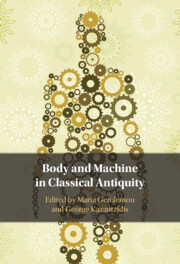Book contents
- Body and Machine in Classical Antiquity
- Body and Machine in Classical Antiquity
- Copyright page
- Contents
- Figures
- Contributors
- An Introduction to Body–Machine Intersections
- Part I Blended Bodies
- Chapter 1 More Than a Thing
- Chapter 2 Automata, Cyborgs, and Hybrids
- Chapter 3 Not Yet the Android
- Part II The Technological Body
- Part III Towards the Mechanization of the Human Body
- Index of Passages
- General Index
- References
Chapter 2 - Automata, Cyborgs, and Hybrids
Bodies and Machines in Antiquity
from Part I - Blended Bodies
Published online by Cambridge University Press: 13 July 2023
- Body and Machine in Classical Antiquity
- Body and Machine in Classical Antiquity
- Copyright page
- Contents
- Figures
- Contributors
- An Introduction to Body–Machine Intersections
- Part I Blended Bodies
- Chapter 1 More Than a Thing
- Chapter 2 Automata, Cyborgs, and Hybrids
- Chapter 3 Not Yet the Android
- Part II The Technological Body
- Part III Towards the Mechanization of the Human Body
- Index of Passages
- General Index
- References
Summary
This chapter proposes that the myths of Hephaistos, the ancient Greek god of metalwork and the only physically impaired member of the Olympic pantheon, can provide insights into ancient inspirations for and understandings of assistive technology. It explores the range of different types of assistive technology that impaired and disabled individuals used in classical antiquity to facilitate their physical mobility, covering staffs, sticks, crutches, corrective footwear, extremity prostheses, conveyances, equids, bearers, and caregivers. It notes the frequent association of impairment and technology in classical antiquity. It argues for a reassessment of the suitability of the Medical Model for use in relation to impairment and disability in classical antiquity under certain circumstances.
- Type
- Chapter
- Information
- Body and Machine in Classical Antiquity , pp. 48 - 69Publisher: Cambridge University PressPrint publication year: 2023



